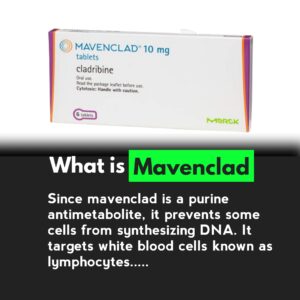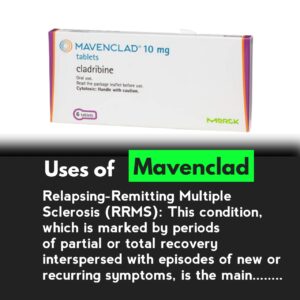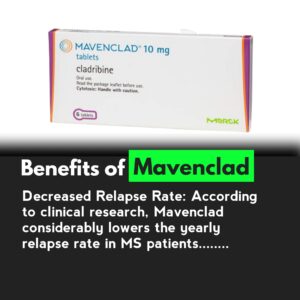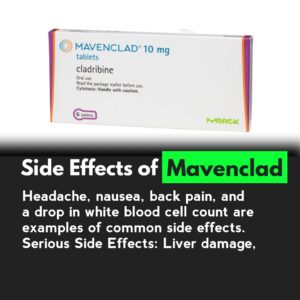Details of Mavenclad Prescribing
Name in generic: Cladribine
Name of Brand: Mavenclad
Form of Dosage: Oral Tablets
Strength: Each tablet contains 10 milligrams.
Introduction
An oral drug for people with multiple sclerosis (MS), an incurable autoimmune disorder that impacts the central nervous system, Mavenclad (cladribine) Mavenclad, an FDA-approved treatment for relapsing forms of MS, is designed to reduce the rate of relapses and slow disability progression for those with these forms of multiple sclerosis. In this piece of writing, an in-depth look at Mavenclad, including its uses in sparing detail and pros and cons information, is offered.
What is Mavenclad?

How Does Mavenclad Work?

Mavenclad works by selectively reducing lymphocytes, specifically B and T cells that are involved in the autoimmune response underlying MS. The drug is taken orally twice a year in two consecutive week-long treatment courses, which are given one month apart.
Uses of Mavenclad

The chief use of Mavenclad is for patients with relapsing-remitting multiple sclerosis (RRMS), a form of the disease characterized by periods of partial or complete recovery alternating with episodes of resumed or worsening symptoms. Active Secondary Progressive Multiple Sclerosis (SPMS): This is where an individual is deteriorating or relapsing over time with SPMS, but are still relapsing.
Benefits of Mavenclad

Side Effects of Mavenclad

These can include headache, nausea, back pain, and a reduction in the number of white blood cells.
Severe side effects: Worsening of white blood cells count can cause infections, liver damage, and increased risk of cancer.
Who Should Not Take Mavenclad?
Preparing for Mavenclad Treatment
Mavenclad Dosing Schedule
Year 2: Follow the same curriculum, finishing the two courses, as in Year 1.
Dosage by Body Weight:
(Table 1: Number of Mavenclad 10 mg tablets per cycle)
| Body Weight Range (kg) | Total Dose (mg) | Number of Tablets per Cycle |
|---|---|---|
| 40 to <50 | 40 | 4 |
| 50 to <60 | 50 | 5 |
| 60 to <70 | 60 | 6 |
| 70 to <80 | 70 | 7 |
| 80 to <90 | 80 | 8 |
| 90 to <100 | 90 | 9 |
| 100 to <110 | 100 | 10 |
| 110 to <120 | 110 | 11 |
| ≥120 | 120 | 12 |
Administration Instructions:
- Take the Mavenclad tablets with water, either before or after eating.
- Chewless pills should be swallowed whole.
- When handling tablets, make sure your hands are dry.
- After handling the tablets, carefully wash your hands.
Contraindications
- Cancers: The risk of cancer may be elevated by mavenclad. Assess the patient’s medical history for cancer prior to prescribing Mavenclad.
- Infections: Mavenclad may raise the risk of infection by lowering lymphocyte levels. Track the number of lymphocytes prior to, during, and following treatment.
- Hematologic Toxicity: To control hematologic toxicity, keep an eye on total blood counts both before and throughout treatment.
- Liver Injury: Keep an eye on liver function tests because hepatotoxicity is a possibility.
Monitoring During Treatment
Any sign of infection or any other side effects felt by the patients should be reported to their healthcare provider immediately. White cell counts and liver function blood tests are performed regularly throughout treatment.
Patient Stories
Information on Patient Counseling
Advise patients of the possibility of infections and cancer.
Encourage patients to utilize reliable birth control both during and after their therapy.
Inform patients of the value of following the prescribed dosing regimen.
Expert Opinions
One of the things healthcare providers emphasize is that treating people with MS is not one-size-fits-all. It is important to note that neurologists argue that Mavenclad does have its place in the MS therapy arsenal as it substantially reduces the likeliness of relapses and disability and even slows down disease development, but only if used appropriately.
FAQs
Is Mavenclad used as a medication?
Antimetabolites are a type of chemotherapeutic agents that induces cell death. However, Mavenclad is not a treatment for cancer. Rather, it is employed as an MS disease-modifying treatment. This indicates that the medication slows the disease’s advancement or deterioration.
How well does Mavenclad MS work?
Comparing Mavenclad to a dummy (an inactive medication), the study’s primary endpoint—the number of relapses—was significantly lower. Compared to 63% of patients who took a placebo, 81% of patients who took Mavenclad saw no relapses over the course of 96 weeks.
How much does Mavenclad cost?
Mavenclad (cladribine) belongs to the drug class of metabolites and is commonly used for multiple sclerosis. A 4-tablet treatment of the oral tablet 10 mg costs roughly $43,839, depending on the pharmacy you visit.
The quoted costs are only applicable for cash-paying clients and do not apply to insurance policies.
What are the long term effects of Mavenclad?
Although uncommon, using Mavenclad may result in long-term adverse effects such as: certain infections, such as shingles (a virus that causes chickenpox), and liver injury. cancer*

[…] Related drugs Urso tablets Mavenclad […]